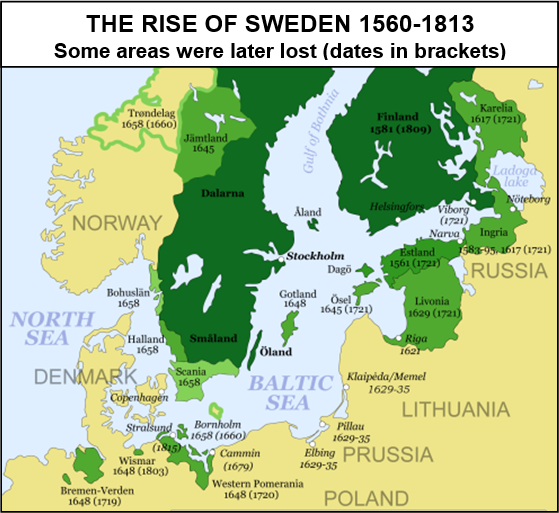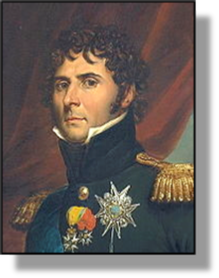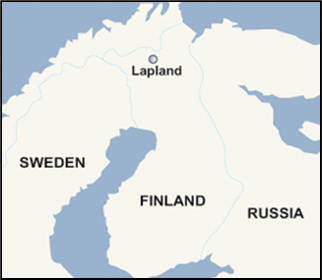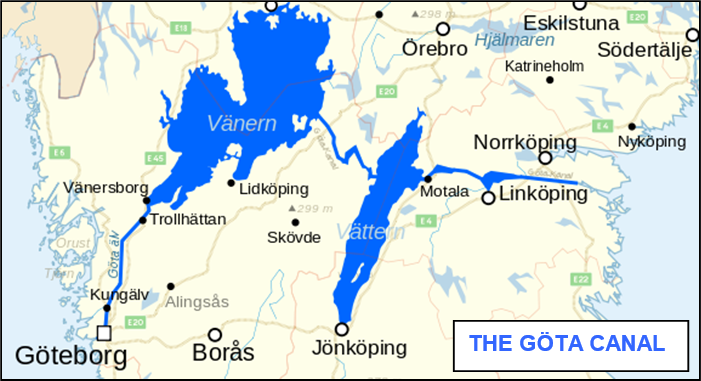


xxxxxAs we have seen, the Union of Kalmar in 1397 (R2) united the kingdoms of Norway, Sweden and Denmark under a single monarch. Then in 1524 (H8), by the Treaty of Malmo, Sweden gained its independence and, given leaders like Gustavus Adolphus and Charles XII, went on to become an important European power until its defeat by the Russians at the Battle of Poltava in 1709. A century later, faced with no heir to their throne, the Swedes chose one of Napoleon’s Marshals, Jean-
THE NAPOLEONIC WARS 1803 -
THE TREATY OF KIEL -
Acknowledgements
Map (Sweden): licensed under Creative Commons. Author: Memnon – http://en.wikipedia.org/wiki/Swedish +Empire. Bernadotte: detail, by the French painter François Gérard (1770-
 xxxxxAs we have seen, by the Union of Kalmar in 1397 (R2), Denmark, for many years the most powerful and successful of the Scandinavian countries, managed to unite the kingdoms of Norway, Sweden and Denmark under a single monarch -
xxxxxAs we have seen, by the Union of Kalmar in 1397 (R2), Denmark, for many years the most powerful and successful of the Scandinavian countries, managed to unite the kingdoms of Norway, Sweden and Denmark under a single monarch -
xxxxxThe coming of the Napoleonic Wars brought changes to Scandinavia. The union of Denmark and Norway tried to remain neutral in the war between France and Great Britain but, being obliged to join Napoleon’s blockade of British ports -
 xxxxxSweden’s take-
xxxxxSweden’s take-
xxxxxIn the spring of 1813 Charles John then approached the British and the Prussian governments, offering the same terms -
xxxxxBy this treaty, Denmark had to cede Norway to Sweden, held since 1388. Though it retained the old Norwegian dependencies of Iceland, the Faroes, and Greenland, this treaty was a bitter blow for Denmark. It was never again to hold such a dominant position in the Baltic region. However, the Danes did make a last-
xxxxxIncidentally, Charles John became king of Sweden and Norway (Charles XIV) upon the death of Charles XIII in February 1818. Good relations with both Russia and Great Britain ensured a long period  of peace, and his domestic reforms helped to expand trade and agriculture. His rule, autocratic in style, aroused a fair amount of opposition in both countries, but he remained in power by dint of his firm administration, and was the founder of the present royal dynasty of Sweden.
of peace, and his domestic reforms helped to expand trade and agriculture. His rule, autocratic in style, aroused a fair amount of opposition in both countries, but he remained in power by dint of his firm administration, and was the founder of the present royal dynasty of Sweden.
xxxxxIn its bid for a national identity, Finland fared no better than her Baltic neighbours. Having been a dependency of Sweden for some 500 years, Russia began to seize parts of the country, first under Peter the Great in 1721 and then during the reign of Empress Elizabeth in 1743.
xxxxxThen in 1809, during the Napoleonic Wars, Sweden was forced to cede the whole country to Tsar Alexander, and the rest of the 19th century witnessed a long and bitter uphill struggle by the Finns to throw off Russian domination. Following the Russian Revolution of 1917, a republic was eventually declared in 1919.
 xxxxxIt was during the reign of Charles XIV that the Göta Canal was completed. The idea of a waterway that crossed southern Sweden from west to east was first considered during the reign of Gustavus Vasa in the 16th century, but the work was not begun in earnest until the early 1800s. Made up of a succession of rivers and lakes linked together by canals, it provided inland navigation from the port of Göteborg on the west coast to Söderköping on the Baltic. Some 60,000 men, digging by hand, were employed in the construction of the 50 miles of artificial waterways needed, and the work was finally completed in 1832. Sweden’s two largest lakes, Lake Vänern and Lake Vättern, form part of the system, and there are 58 locks along its way.
xxxxxIt was during the reign of Charles XIV that the Göta Canal was completed. The idea of a waterway that crossed southern Sweden from west to east was first considered during the reign of Gustavus Vasa in the 16th century, but the work was not begun in earnest until the early 1800s. Made up of a succession of rivers and lakes linked together by canals, it provided inland navigation from the port of Göteborg on the west coast to Söderköping on the Baltic. Some 60,000 men, digging by hand, were employed in the construction of the 50 miles of artificial waterways needed, and the work was finally completed in 1832. Sweden’s two largest lakes, Lake Vänern and Lake Vättern, form part of the system, and there are 58 locks along its way.
xxxxxThe Scottish civil engineer Thomas Telford, who began work on the Caledonian Canal in Scotland in 1803, was invited over to Sweden to give his advice. He spent six weeks during the summer of 1808, working out a detailed layout of the canal and the siting of its many locks.
xxxxxThe total distance from Göteborg to Stockholm via the Göta Canal is 347 miles compared with 590 miles by sea. However, since the introduction of steam vessels and the railway, the canal has lost much of its commercial importance. It is still used for local trading, but it now serves as a major tourist attraction with voyages along it taking three days.
Including:
Jean-
Finland and the Göta Canal

G3c-



1814